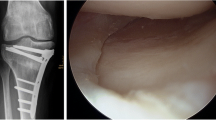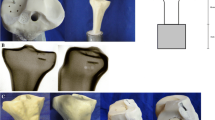Summary
As biodegradable pins and screws have increasingly been used in the internal fixation of fractures, sterile inflammatory reactions have occasionally occurred. The aim of the present experimental study was to assess the cellular response within cancellous bone to biodegradable polyester screws. In 45 rabbis a transverse distal femoral osteotomy was fixed with a 4.5 × 30 mm screw made either of polyglycolide (PGA, in 20 rabbits) or polylactide (PLA, in 25 rabbits). The follow-up times were 3, 6, 12, 36 or 48 weeks. The time-related and spatial characteristics of the cellular response were examined histomorphometrically using standardised sample fields under polarised-light microscopy. Polymorphonuclear granulocytes and mononuclear round cells were scarce in all follow-up groups. The occurrence of phagocytic cells (mononuclear macrophages and foreign-body giant cells) was highest in the PGA-fixed 12-week specimens. The giant cells seemed to adhere to the implant surface at an early stage, whereas the ultimate digestion and clearing of the decomposing polymeric material later on were performed by macrophages invading the implant body. No PGA was left in the 36-week specimens, while the gross geometry of the PLA screws was still intact at 48 weeks. In conclusion, the inflammatory response to these polymers was quite mild. Thus it seems probable that some other additional factors must influence the occurrence of the clinical inflammatory reactions.
Similar content being viewed by others
References
Bos RRM, Rozema FR, Boering G, Nijenhuis AJ, Pennings AJ, Verwey AB, Nieuwenhuis P, Jansen HWB (1991) Degradation of and tissue reaction to biodegradable poly(L-lactide) for use as internal fixation of fractures: a study in rats. Biomaterials 12:32–61
Böstman OM (1919) Absorbable implants for the fixation of fractures. J Bone Joint Surg [Am] 73:148–153
Böstman O, Vainionpää S, Hirvensalo E, Mäkelä A, Vihtonen K, Törmälä P, Rokkanen P (1987) Biodegradable internal fixation for malleolar fractures. A prospective randomised trial. J Bone Joint Surg [Br] 69:615–694
Böstman O, Hirvensalo E, Mäkinen J, Rokkanen P (1990) Foreign-body reactions to fracture fixation implants of biode gradable synthetic polymers. J Bone Joint Surg [Br] 72:592–596
Delbeke LO, Gomel V, McComb PF, Jetha N (1983) Histologic reaction to four synthetic microsutures in the rabbit. Fertil Steril 40:248–252
Eitenmüller J, David A, Muhr G (1990) Treatment of ankle fractures with complete biodegradable plates and screws of high molecular weight polylactide. Read at the 92nd French Surgical Congress, Paris
Fridén T, Rydholm U (1992) Severe aseptic synovitis of the knee after biodegradable internal fixation. A case report. Acta Orthop Sand 63:94–97
Gammelgaard N, Jensen J (1983) Wound complications after closure of abdominal incisions with Dexon or Vicryl: a randomized double-blind study. Acta Chir Scand 149:505–508
Hoffmann R, Krettek C, Haas N, Tscherne H (1989) Die distale Radiusfraktur. Frakturstabilisierung mit biodegradablen Osteosynthese-Stiften. Experimentelle Untersuchungen und erste klinische Erfahrungen. Unfallchirurg 92:430–434
Majola A (1991) Fixation of experimental osteotomies with absorbable polylactic acid screws. Ann Chir Gynaecol 80:274–281
Matlaga BF, Salthouse TN (1983) Ultrastructural observations of cells at the interface of a biodegradable polymer: Polyglactin 910. J Biomed Mater Res 17:185–197
Mero M, Vainionpääs S, Vasenius J, Vihtonen K, Rokkanen P (1989) Medetomidine-ketamine-diazepam anesthesis in the rabbit. Acta Vet Scand 85:135–137
Miller RA, Brady JM, Cutright DE (1977) Degradation rates of oral resorbable implants (polylactates and polyglycolates): rate modification with changes in PLA/PGA copolymer ratios. J Biomed Mater Res 11:711–719
Murray DW, Rushton N (1990) Macrophages stimulate bone resorption when they phagocytose particles. J Bone Joint Surg [Br] 72:988–992
Poigenfürst J, Leixnering M, Ben Mokhtar M (1990) Lokalkomplikationen nach Implantation von Biorod. Aktuel Traumatol 20:157–160
Rokkanen P (1990) Absorbable implants in the fixation of fractures. Ann Chir Gynaecol 79:117–122
Rokkanen P, Böstman O, Vainionpää S, Vihtonen K, Törmälä P, Laiho J, Kilpikari J, Tamminmäki M (1985) Biodegradable implants in fracture fixation: early results of treatment of fractures of the ankle. Lancet 1:1422–1424
Schenk RK (1965) Zur histologischen Verarbeitung von unentkalkten Knochen. Acta Anat 60:3–19
Törmälä P, Vasemus J, Vainionpää S, Laiho J, Pohjonen T, Rokkanen P (1991) Ultra-high-strenght absorbable self-reinforced polyglycolide (SR-PGA) composite rods for internal fixation of bone fractures: in vivo and in vitro study. J Biomed Mater Res 25:1–22
Wüstner MC, Partecke BD, Buck-Gramcko D (1986) Resorbierbare PDS-Splinte zur Frakturstabilisierung und für Arthrodesen und der Hand. Handchir Mikrochir Plast Chir 18:298–301
Author information
Authors and Affiliations
Rights and permissions
About this article
Cite this article
Päivärinta, U., Böstman, O., Majola, A. et al. Intraosseous cellular response to biodegradable fracture fixation screws made of polyglycolide or polylactide. Arch Orthop Trauma Surg 112, 71–74 (1993). https://doi.org/10.1007/BF00420258
Received:
Issue Date:
DOI: https://doi.org/10.1007/BF00420258




